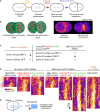Equatorial Non-muscle Myosin II and Plastin Cooperate to Align and Compact F-actin Bundles in the Cytokinetic Ring
- PMID: 33102479
- PMCID: PMC7546906
- DOI: 10.3389/fcell.2020.573393
Equatorial Non-muscle Myosin II and Plastin Cooperate to Align and Compact F-actin Bundles in the Cytokinetic Ring
Abstract
Cytokinesis is the last step of cell division that physically partitions the mother cell into two daughter cells. Cytokinesis requires the assembly and constriction of a contractile ring, a circumferential array of filamentous actin (F-actin), non-muscle myosin II motors (myosin), and actin-binding proteins that forms at the cell equator. Cytokinesis is accompanied by long-range cortical flows from regions of relaxation toward regions of compression. In the C. elegans one-cell embryo, it has been suggested that anterior-directed cortical flows are the main driver of contractile ring assembly. Here, we use embryos co-expressing motor-dead and wild-type myosin to show that cortical flows can be severely reduced without major effects on contractile ring assembly and timely completion of cytokinesis. Fluorescence recovery after photobleaching in the ingressing furrow reveals that myosin recruitment kinetics are also unaffected by the absence of cortical flows. We find that myosin cooperates with the F-actin crosslinker plastin to align and compact F-actin bundles at the cell equator, and that this cross-talk is essential for cytokinesis. Our results thus argue against the idea that cortical flows are a major determinant of contractile ring assembly. Instead, we propose that contractile ring assembly requires localized concerted action of motor-competent myosin and plastin at the cell equator.
Keywords: C. elegans; actomyosin contractility; contractile ring; cortical flows; cytokinesis; non-muscle myosin II; plastin/fimbrin.
Copyright © 2020 Leite, Chan, Osório, Saramago, Sobral, Silva, Gassmann and Carvalho.
Figures





Similar articles
-
Plastin and spectrin cooperate to stabilize the actomyosin cortex during cytokinesis.Curr Biol. 2021 Dec 20;31(24):5415-5428.e10. doi: 10.1016/j.cub.2021.09.055. Epub 2021 Oct 18. Curr Biol. 2021. PMID: 34666005 Free PMC article.
-
Crosslinking activity of non-muscle myosin II is not sufficient for embryonic cytokinesis in C. elegans.Development. 2019 Nov 12;146(21):dev179150. doi: 10.1242/dev.179150. Development. 2019. PMID: 31582415 Free PMC article.
-
Anillin and the septins promote asymmetric ingression of the cytokinetic furrow.Dev Cell. 2007 May;12(5):827-35. doi: 10.1016/j.devcel.2007.02.018. Dev Cell. 2007. PMID: 17488632
-
Network Contractility During Cytokinesis-from Molecular to Global Views.Biomolecules. 2019 May 18;9(5):194. doi: 10.3390/biom9050194. Biomolecules. 2019. PMID: 31109067 Free PMC article. Review.
-
Processes Controlling the Contractile Ring during Cytokinesis in Fission Yeast, Including the Role of ESCRT Proteins.J Fungi (Basel). 2024 Feb 15;10(2):154. doi: 10.3390/jof10020154. J Fungi (Basel). 2024. PMID: 38392827 Free PMC article. Review.
Cited by
-
Plastin and spectrin cooperate to stabilize the actomyosin cortex during cytokinesis.Curr Biol. 2021 Dec 20;31(24):5415-5428.e10. doi: 10.1016/j.cub.2021.09.055. Epub 2021 Oct 18. Curr Biol. 2021. PMID: 34666005 Free PMC article.
-
Anillin forms linear structures and facilitates furrow ingression after septin and formin depletion.Cell Rep. 2023 Sep 26;42(9):113076. doi: 10.1016/j.celrep.2023.113076. Epub 2023 Sep 3. Cell Rep. 2023. PMID: 37665665 Free PMC article.
-
Anillin mediates unilateral furrowing during cytokinesis by limiting RhoA binding to its effectors.J Cell Biol. 2025 Jun 2;224(6):e202405182. doi: 10.1083/jcb.202405182. Epub 2025 Apr 22. J Cell Biol. 2025. PMID: 40261302
-
Diversity is the spice of life: An overview of how cytokinesis regulation varies with cell type.Front Cell Dev Biol. 2022 Nov 7;10:1007614. doi: 10.3389/fcell.2022.1007614. eCollection 2022. Front Cell Dev Biol. 2022. PMID: 36420142 Free PMC article. Review.
-
β-heavy-spectrin stabilizes the constricting contractile ring during cytokinesis.J Cell Biol. 2023 Jan 2;222(1):e202202024. doi: 10.1083/jcb.202202024. Epub 2022 Oct 11. J Cell Biol. 2023. PMID: 36219157 Free PMC article.
References
LinkOut - more resources
Full Text Sources
Research Materials

